I once chose the wrong dry van trailer.
It looked fine—until loading day. The floor flexed, the doors jammed, and unloading was a mess. We had to swap trailers mid-project. It costs us time, money, and trust.
Over the years, I’ve worked with crews in construction, mining, agriculture, and long-haul transport—helping them avoid mistakes like that.
If you’re trying to figure out which dry van trailer fits your cargo, this guide is for you.
We’ll cover 10 types. You’ll see how each one works, what it’s built for, and how to match it to your job—whether you move light freight or heavy gear.
By the end, you’ll have a clear way to match trailer features to your work—so you don’t waste time or money on the wrong fit.
So let’s get down to it!
Quick Comparison Table
Here’s a side-by-side comparison to help you scan through key details fast. We’ll go deeper into each trailer type in the sections that follow.
| Trailer Type | Length | Interior Height | Best For | Key Feature |
| Standard Dry Van (53 ft) | 53 ft | ~110 in | General dry freight | Most common and dock-compatible |
| High Cube Dry Van | 53 ft | 114–120 in | Bulky but light goods | Extra vertical space |
| Drop Deck Dry Van | 48–53 ft | Up to 128 in (lower) | Tall or heavy equipment | Two deck heights for oversize cargo |
| Insulated Dry Van | 48–53 ft | ~106–108 in | Heat/cold-sensitive items | Passive thermal protection |
| Vented Dry Van | 48–53 ft | ~110 in | Produce, grains, curing materials | Passive airflow through side/rear vents |
| Rolling-Floor Dry Van | 48–53 ft | 108–110 in | Bulk freight like recyclables or feed | Motorized floor for self-unloading |
| Curtain-Side Dry Van | 48–53 ft | ~108 in | Long or odd-shaped materials | Flexible side access via curtain walls |
| Pup Dry Van | ~28 ft | ~108 in | LTL freight, city delivery | Compact and easy to maneuver |
| Double Dry Van Trailers | Two 28-ft pups | ~108 in | High-volume parcel or LTL loads | Pulled in tandem, needs CDL doubles cert |
| Straight Truck (Box Truck) | Under 26 ft | ~90–100 in | Last-mile and local delivery | One-piece unit, no trailer/tractor separation |
Now that you’ve seen the basics side by side, let’s break down what each trailer offers in more detail.
1. Standard Dry Van Trailer (53 ft)
I once saw a crew struggle for hours because they picked the wrong trailer. The load didn’t fit right, the dock wasn’t aligned, and it threw off their whole day. That’s when I realized how much trailer type matters.
The 53-foot dry van is the most common trailer on the road—and for good reason. It’s simple, dependable, and works across many industries. At Rhinotrail, we offer custom-built standard dry vans designed to handle a wide range of cargo and dock setups. If you’re hauling dry freight, this is often the first and best place to start.
Specification
- Overall Length: 53 feet
- Interior Width: 102 inches
- Interior Height: Around 110 inches
- Cargo Volume: Roughly 3,500 cubic feet
- Floor: Durable hardwood for pallet jacks and forklifts
- Frame: Steel or aluminum with enclosed sides and roof
- Doors: Swing doors standard; roll-up optional
- Dock Compatibility: Matches most standard loading docks
- Axle Configuration: Tandem axle for steady highway hauling
Best For
- General dry goods
- Non-perishable food
- Retail and boxed products
- Furniture and light industrial cargo
- Palletized freight
Pros and Cons
Pros
- Widely available and easy to source
- Compatible with most docks
- Large interior space for boxed freight
- Lower cost than specialty trailers
Cons
- Not suitable for temperature-sensitive cargo
- Can’t haul oversized or oddly shaped loads
- No side loading access
Why Choose It
This trailer is trusted across industries because it’s practical, reliable, and simple to use. It’s easy to load, fits in with standard shipping setups, and doesn’t require special handling. Over the years, I’ve seen many first-time buyers start with this trailer—and it usually turns out to be the right call for dry freight.
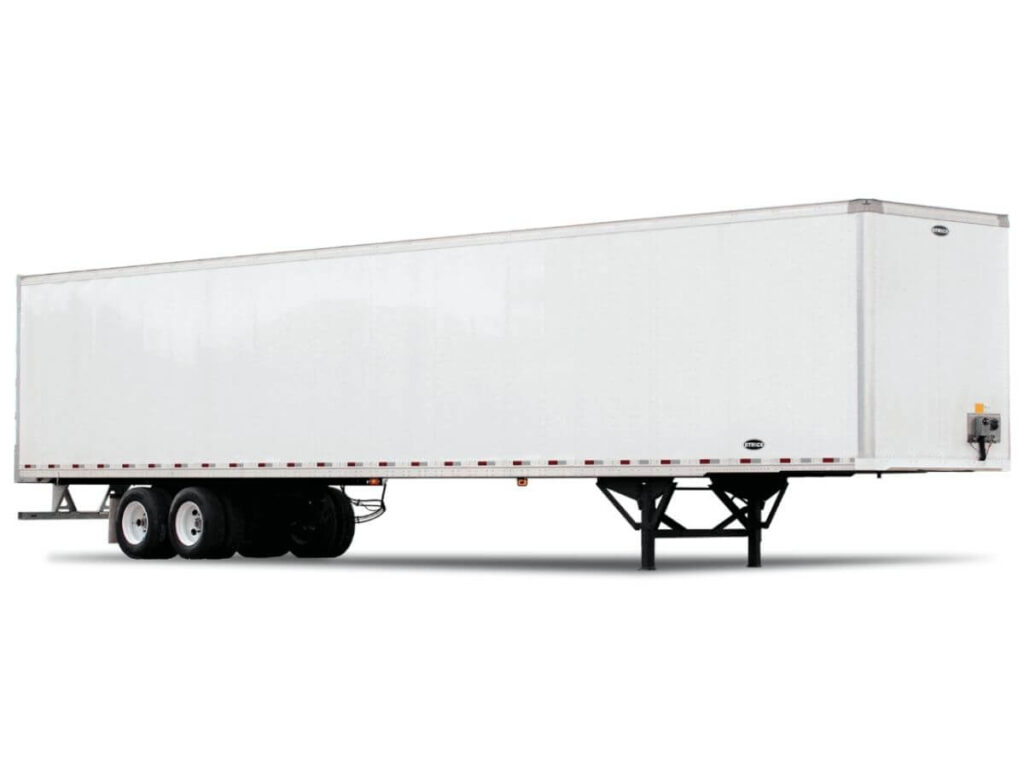
2. High Cube Dry Van Trailer
You’ve probably had a load that wasn’t heavy—but still didn’t fit. Maybe the items were tall, awkward, or just took up more room than expected. If that sounds familiar, a high cube dry van could make your job a lot easier.
This trailer gives you extra height inside. From the outside, it looks like a standard dry van. But once you open those doors, you’ll notice the extra space right away.
Specification
- Overall Length: 53 feet
- Interior Width: 102 inches
- Interior Height: 114 to 120 inches
- Cargo Volume: Up to 4,000 cubic feet
- Floor: Strong hardwood, made for forklifts
- Frame: Fully enclosed, steel or aluminum
- Doors: Standard swing doors
- Dock Compatibility: Matches most dock heights
- Axle Setup: Tandem axle for balanced loads
Best For
- Large, lightweight freight
- Furniture and display items
- Empty containers or bins
- Plastic goods
- Agricultural packaging supplies
Pros and Cons
Pros
- More interior height for stacking
- Great for cargo that’s big but not heavy
- Works with standard loading docks
Cons
- Doesn’t increase weight capacity
- May be less common than standard trailers
- Taller buildings could affect fuel economy slightly
Why Choose It
If you’re tired of leaving space unused because your load hits the roof too soon, this trailer solves that problem. You can stack more, haul more, and get better use out of every trip—without changing your equipment or your process.
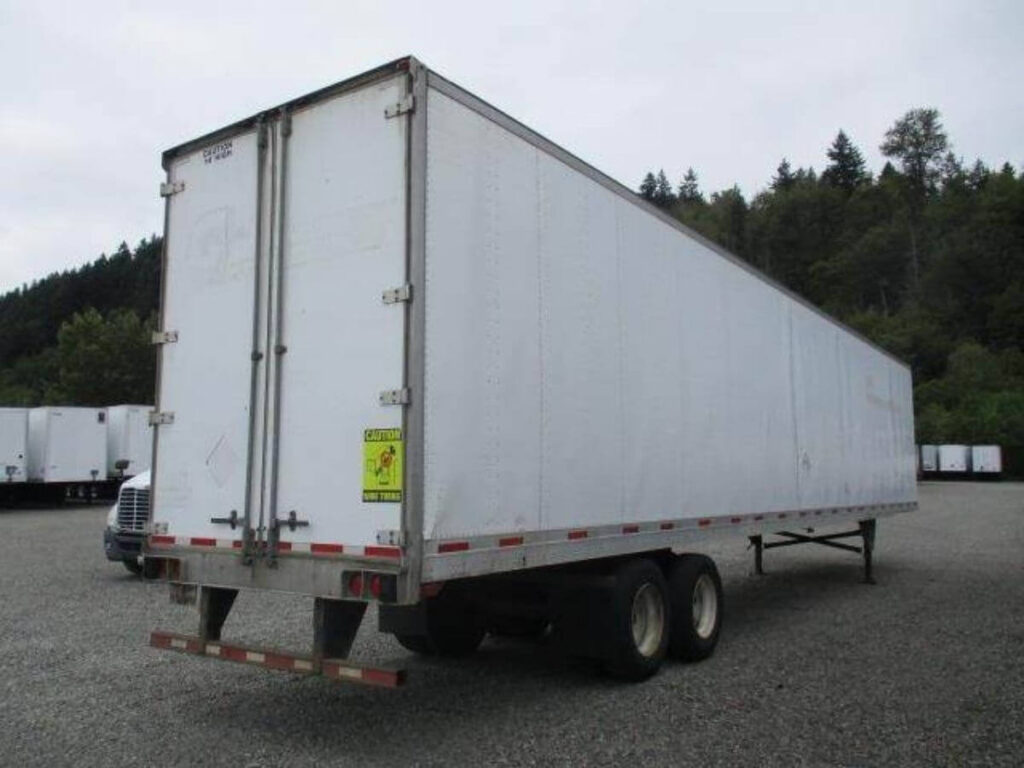
3. Drop Deck Dry Van Trailer (Step Deck Enclosed)
Have you ever had a load that was just a few inches too tall for your standard dry van? You stack everything carefully, measure twice, and still—those last few inches stop the doors from closing. If you’ve been there, you know how frustrating that is.
That’s where a drop deck dry van can help. This trailer has two levels inside—an upper and a lower deck. That lower section gives you more vertical clearance to fit taller cargo without needing special permits.
Specification
- Overall Length: Usually 48 to 53 feet
- Interior Width: 102 inches
- Upper Deck Height: Similar to standard (around 110 inches)
- Lower Deck Height: Offers an extra 12–18 inches of clearance
- Floor: Reinforced hardwood or steel for heavier loads
- Frame: Fully enclosed with steel or aluminum sides
- Axle Setup: Tandem axle, strong enough for heavy cargo
- Dock Compatibility: May need ramp or lift due to lower section
Best For
- Oversized machinery that doesn’t fit in a regular van
- Palletized parts or gear with extra height
- Industrial loads like pumps, generators, or framed equipment
- Projects in construction, mining, or energy sectors
Pros and Cons
Pros
- Extra internal height for tall or stacked cargo
- Can help avoid permits for over-height loads
- Fully enclosed, so your freight stays protected
Cons
- May not load evenly if not planned right
- The lower section may require special dock or ramp
- Not as widely available as standard dry vans
Why Choose It
If your cargo is tall, heavy, or shaped in a way that standard trailers just can’t handle, this trailer gives you more options. You get more room inside without the extra paperwork or hauling a flatbed. If your work involves tough equipment or specialty parts, this setup might be exactly what you need.
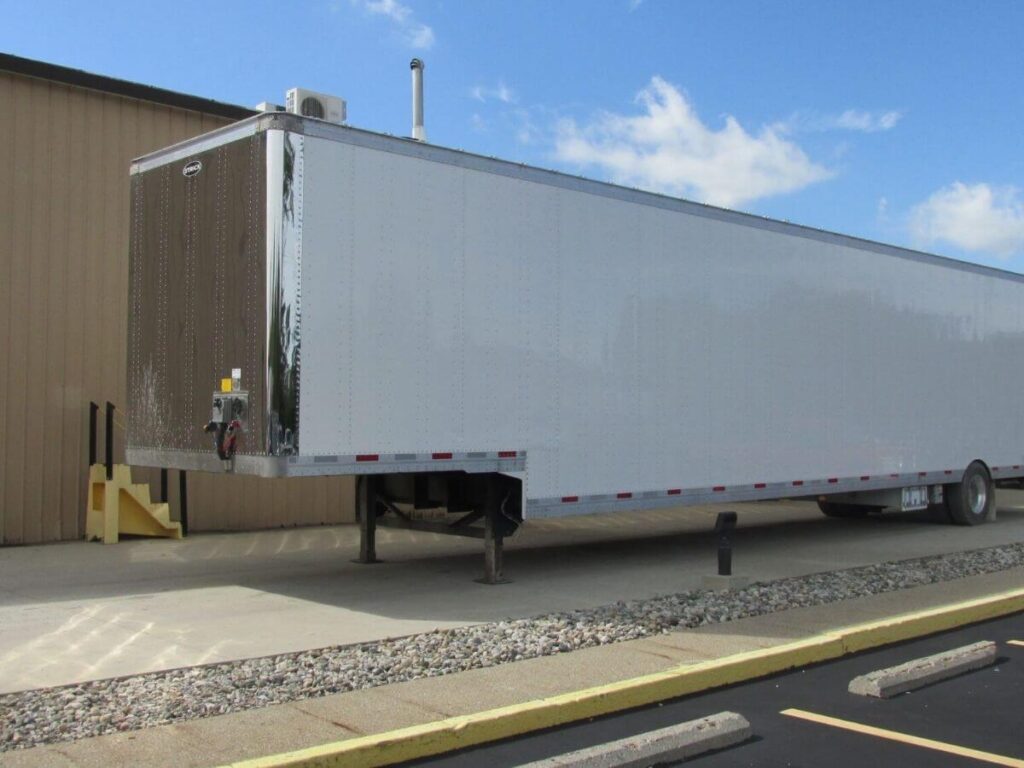
4. Insulated Dry Van Trailer
Imagine opening your trailer on a hot afternoon and being hit with warm, stale air—and seeing your cargo slightly warped or labels peeling from the heat. If you’ve been there, you know that even a few degrees can damage your load.
An insulated dry van helps protect your freight from those temperature swings. It doesn’t cool like a reefer, but it acts like a thermal barrier, keeping the inside more stable as outside conditions change.
Specification
- Length: Usually 48 to 53 feet
- Interior Width: 102 inches
- Interior Height: Slightly reduced (about 106–108 inches due to insulation)
- Walls: Lined with foam or fiberglass insulation
- Cooling Unit: None—passive temperature control only
- Doors: Sealed swing doors to hold internal air
- Floor: Standard wood or composite
- Axle Setup: Tandem axle, built for long-distance hauls
Best For
- Food items that can’t melt or freeze
- Industrial chemicals that react to heat
- Consumer electronics in long transit
- Pharmaceuticals that need stable conditions
- Items stored in non-climate-controlled warehouses
Pros and Cons
Pros
- Shields cargo from heat and cold
- No fuel or engine maintenance like a reefer
- Great for partial loads or shared freight with varying needs
Cons
- Won’t keep items cold—only slows down temperature changes
- Slightly less space due to wall insulation
- Not made for frozen or chilled products
Why Choose It
If you’re moving freight that doesn’t need to be cold—but can’t be exposed to harsh weather—a trailer like this gives you that balance. You protect sensitive cargo from cracking, melting, or softening during the ride.
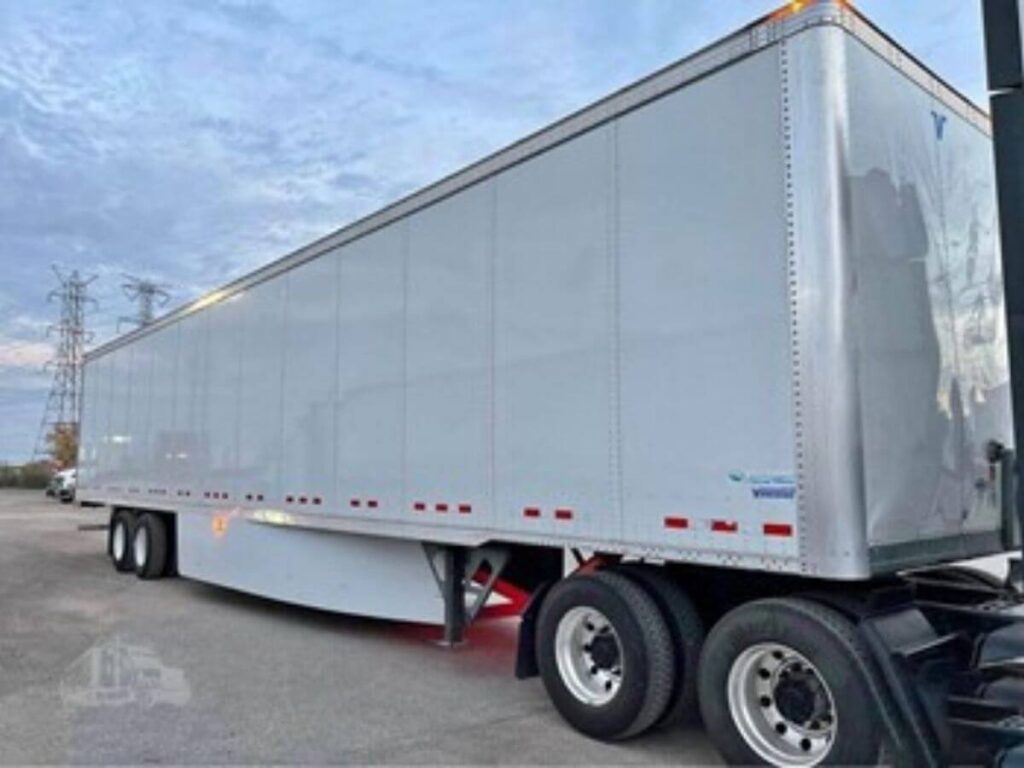
5. Vented Dry Van Trailer
You know that smell of fresh produce right after it’s been picked? It’s great in the field—but inside a sealed trailer on a hot day, that same smell can turn sour fast. That’s where a vented dry van trailer comes in.
If you haul goods that need airflow but don’t need to stay cold, this trailer gives you that sweet spot. It keeps the air moving without the cost or complexity of refrigerated or insulated units.
Specification
- Length: 48 to 53 feet
- Interior Width: 102 inches
- Interior Height: Around 110 inches
- Ventilation: Passive side or rear vents (no fans or power)
- Frame: Enclosed steel or aluminum body
- Floor: Standard wood or composite
- Doors: Swing doors with vent options
- Axle Setup: Tandem axle for stable loads
Best For
- Farm produce that needs to breathe
- Nursery stock and plants
- Sacked grains or feed bags
- Construction materials that release moisture
- Products that sweat or give off natural gases
Pros and Cons
Pros
- Allows airflow to protect sensitive cargo
- Cheaper than reefers or insulated vans
- Good for short hauls or mild weather
Cons
- No control over outside air—depends on the weather
- Not suitable for long-distance temperature-sensitive freight
- Limited use outside specific industries
Why Choose It
If you’re hauling items that need to breathe—like fresh crops, bagged feed, or even damp materials that need to cure—this trailer is a solid choice. I’ve seen it used during early harvest season when temperatures are mild but airflow still matters. You keep your cargo from overheating, without having to run a reefer.
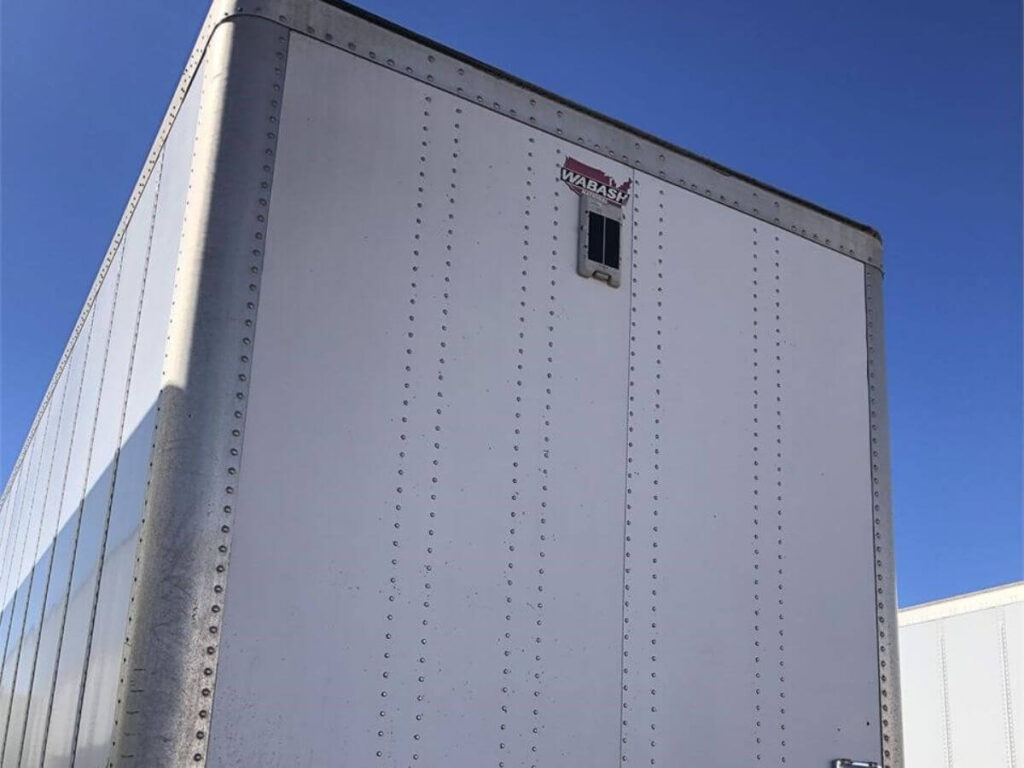
6. Rolling-Floor Dry Van Trailer (Live Floor Trailer)
You know what it’s like to arrive at a site with no dock, no forklift, and no help. That kind of delay slows everything down. A rolling-floor dry van, also called a live floor trailer, helps you avoid all that.
This trailer comes with a moving floor system. It unloads cargo for you—no extra equipment, no wasted time. At Rhinotrail, we offer reliable live floor trailers built for smooth, efficient unloading, even in busy or remote delivery locations. It’s a smart option when you need to keep freight moving without interruption.
Specification
- Length: Typically 48 to 53 feet
- Interior Width: 102 inches
- Interior Height: About 108 to 110 inches
- Floor: Slatted live floor system powered by hydraulics
- Power Source: Truck-driven hydraulic unit
- Doors: Rear swing doors with secure locks
- Body Type: Fully enclosed steel or aluminum
- Axle Setup: Tandem or tri-axle depending on load type
Best For
- Bagged grains or feed
- Loose recyclables
- Agricultural bulk products
- Sand, gravel, or crushed materials
- Waste hauling and transfer jobs
Pros and Cons
Pros
- Automatic unloading without a forklift
- Saves time at sites without docks
- Safer handling of heavy, loose cargo
Cons
- Heavier trailer due to motorized floor
- Higher maintenance compared to standard floors
- Less efficient for small, boxed freight
Why Choose It
If you deliver to sites with limited equipment, this trailer makes your work easier. You stay in control of the unloading process and move freight quickly—without relying on anyone else. It’s a smart choice for jobs where bulk cargo meets tough conditions.
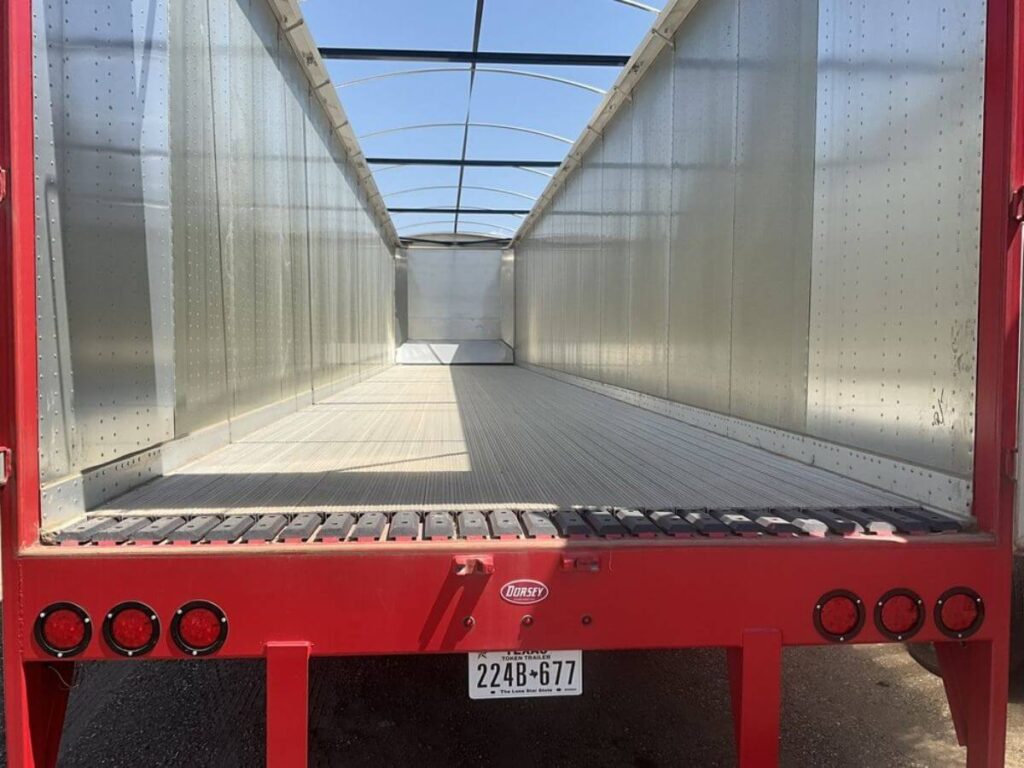
7. Curtain-Side Dry Van Trailer
“This won’t fit through the back.” I remember hearing that at a job site where we were trying to unload steel beams. No dock, no forklift access from the rear—just a growing headache. If you’ve ever been in that kind of situation, you know how much easier things would be with side access.
That’s where a curtain-side dry van trailer comes in. You get the structure of a dry van, but with the flexibility to load from the side.
Specification
- Length: 48 to 53 feet
- Interior Width: 100 to 102 inches
- Interior Height: About 108 inches
- Roof: Solid (usually aluminum or fiberglass)
- Sides: Sliding curtain system (vinyl or heavy-duty fabric)
- Rear: Standard swing doors
- Axle Setup: Tandem axle, standard for general freight
Best For
- Long or oversized products like pipes or beams
- Palletized freight where side access speeds up the process
- Displays and retail goods for quick setup
- Construction or renovation supplies
- Manufacturing equipment with odd shapes
Pros and Cons
Pros
- Fast side loading—no need for a dock
- Great for unusual cargo shapes or long materials
- Still protects freight like a standard dry van
Cons
- Side curtains may wear faster than solid walls
- Less secure than rigid sides for high-value loads
- Not ideal for stacked pallets or tight spaces
Why Choose It
If you’re hauling materials that don’t load easily from the back, this trailer gives you options. You can pull into a job site, slide the curtain open, and get straight to work. It’s a solid pick when flexibility matters more than having all four walls locked tight.
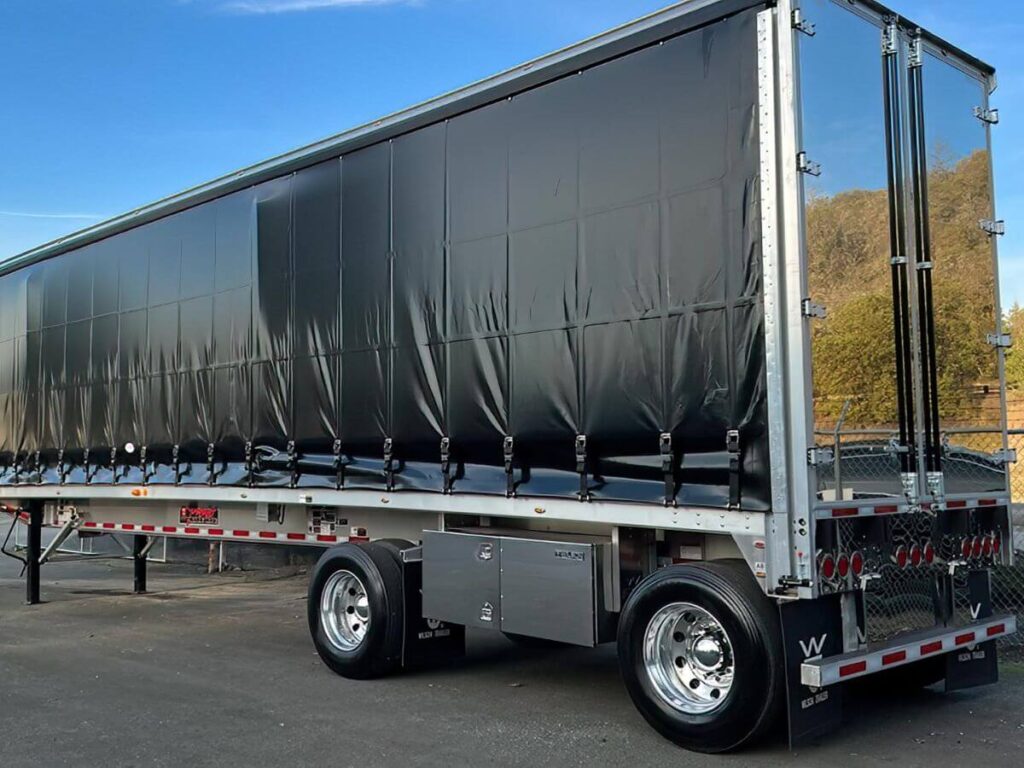
8. Pup Dry Van Trailer
“You’ll never make that turn with a full-size trailer,” the warehouse guy said as I backed into a narrow alley downtown. He was right. That’s when I first saw the value of a pup trailer—small, sharp, and built for jobs like this.
If you haul freight in busy cities, tight corners, or split loads, a pup dry van can make your life a lot easier.
Specification
- Length: Around 28 feet
- Interior Width: 96 to 102 inches
- Interior Height: About 108 inches
- Cargo Volume: Around 1,800 to 2,000 cubic feet
- Doors: Standard swing doors at the rear
- Frame: Enclosed steel or aluminum body
- Axle Setup: Single or tandem axle
Best For
- Inner-city deliveries
- Split routes for multiple stops
- Retail store deliveries
- Food and beverage drop-offs
- Parcel and courier freight
Pros and Cons
Pros
- Easy to maneuver in tight areas
- Great for short hauls or multi-stop runs
- Can be pulled as doubles (2 pups connected) for added capacity
Cons
- Less space than full-size trailers
- Not ideal for heavy or oversized loads
- Requires extra skill when driving doubles
Why Choose It
If you’re running daily routes through cities or making multiple stops, this trailer helps you move fast without fighting for space. You can get into tight spots, unload quickly, and stay on schedule.
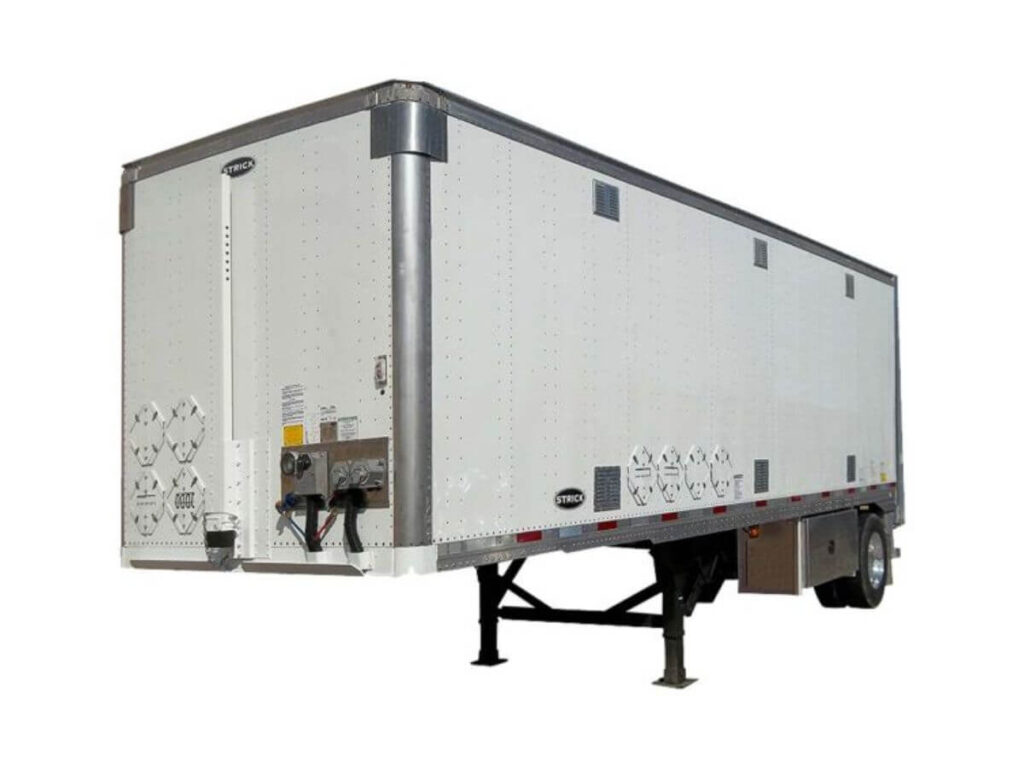
9. Double Dry Van Trailers (Doubles)
You’ve probably seen them on the highway—two short trailers pulled in a row, weaving through traffic with surprising control. The first time I watched a skilled driver back them up into a lot, I thought, that takes some real practice.
If you move a high volume of LTL freight or small parcel loads, running doubles might be the right setup for you.
Specification
- Trailer Type: 2 pup dry vans, usually 28 feet each
- Total Length (with tractor): Around 75 feet, depending on configuration
- Interior Width: 96–102 inches per trailer
- Interior Height: Around 108 inches
- Axle Setup: Each trailer has its own axle group
- Doors: Rear swing doors on both units
- Connection: Pintle hook or converter dolly
Best For
- Large parcel carriers
- Postal and courier services
- Regional LTL shipping networks
- Multi-stop, high-volume distribution routes
Pros and Cons
Pros
- Boosts total cargo volume without a single long trailer
- Efficient for organized LTL operations
- Easier to split loads between two delivery zones
Cons
- More difficult to handle and back up
- State laws vary—some routes don’t allow doubles
- Requires specialized training and certified drivers
Why Choose It
If you’re moving a lot of freight in smaller batches, doubles let you haul more without making extra trips. You save time, space, and fuel—as long as your route allows it. To run doubles, you’ll need a special tractor that can handle tandem trailers, and your driver must have a doubles endorsement on their CDL (commercial driver’s license).
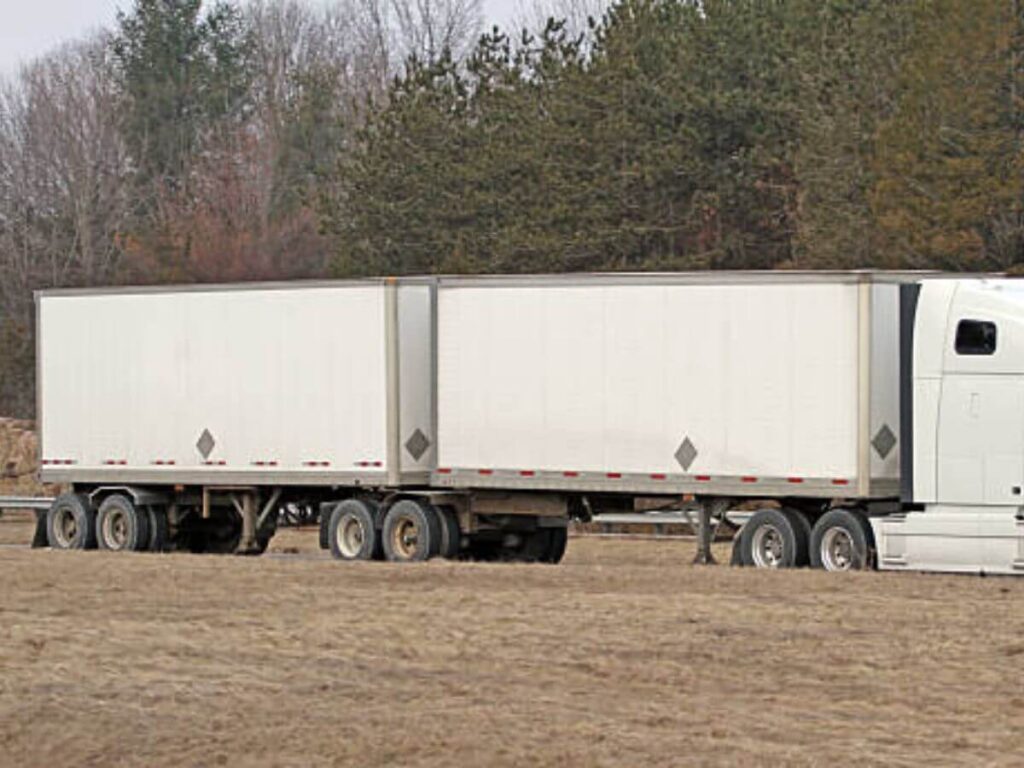
10. Straight Truck (Box Truck)
The sound of a box truck rolling up—brakes hissing, ramp dropping, cargo doors swinging open—is a daily rhythm on short delivery routes. It’s a common sight in cities, loading zones, and store backdoors. These trucks are built for quick stops and tight spaces.
A straight truck, or box truck, has the cab and cargo area combined into one solid unit. It’s not like a semi-trailer—you can’t detach anything. It’s simple, efficient, and perfect for local hauls.
Specification
- Truck Type: All-in-one (cab and cargo box connected)
- Length: Usually under 26 feet
- Interior Width: Around 96 inches
- Interior Height: Roughly 90–100 inches, depending on the model
- Cargo Space: Smaller than standard trailers
- Doors: Rear roll-up or swing; some have side access
- Liftgate: Often included for easy curbside unloading
- License: May not require a CDL for smaller models (check local rules)
Best For
- Last-mile deliveries
- Appliance or furniture drop-offs
- Office supplies and electronics
- Retail store restocks
- Local freight and vendor deliveries
Pros and Cons
Pros
- Easy to drive in city traffic
- No separate tractor required
- Fast loading and unloading at small sites
Cons
- Limited space and lower payload
- Not suitable for long-haul work
- Less flexibility with equipment upgrades
Why Choose It
If your job keeps you close to town, this setup works well. It handles well in traffic, fits into tight delivery zones, and doesn’t need a large crew to operate. For local businesses, delivery teams, or light freight, a box truck keeps the process smooth and simple.
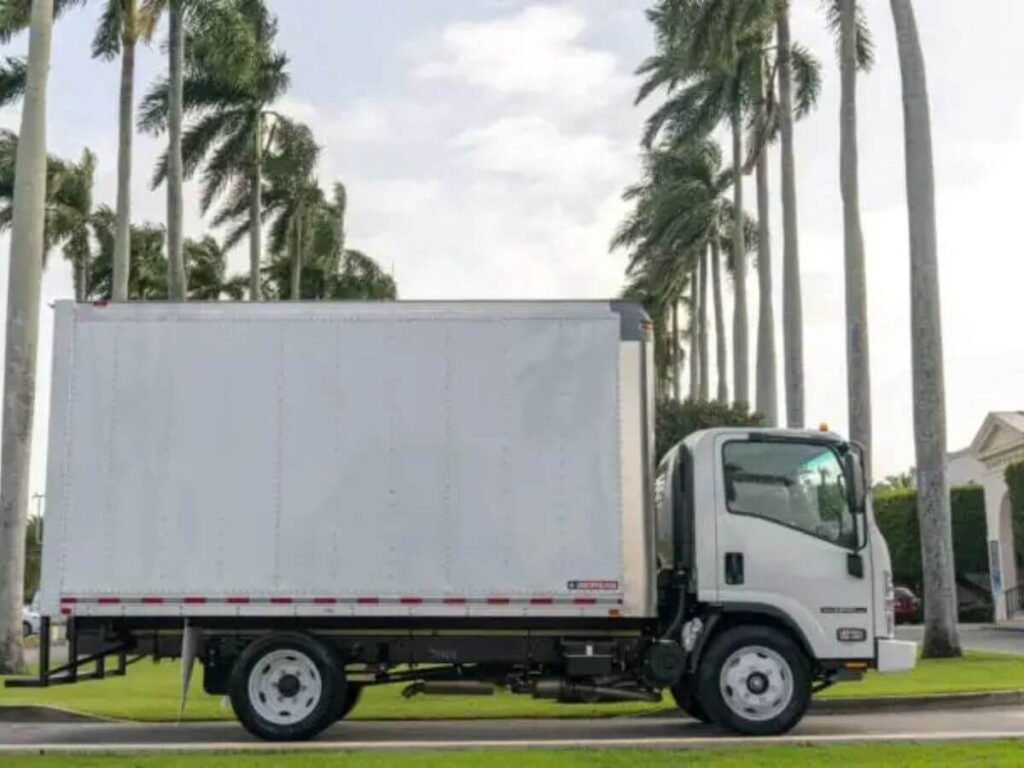
Conclusion
You made it through all 10 types. That says something.
You care about your cargo. You want the right trailer. And now? You’re ready to make a better choice.
This guide walked you through size, shape, loading access, and special features. No fluff. Just what works.
I’ve been there too—learning the hard way. But you don’t have to.
Contact us now—we’re ready to help.


